Buffaloed
webmaster
Coronavirus drifts through the air in microscopic droplets – here's the science of infectious aerosols
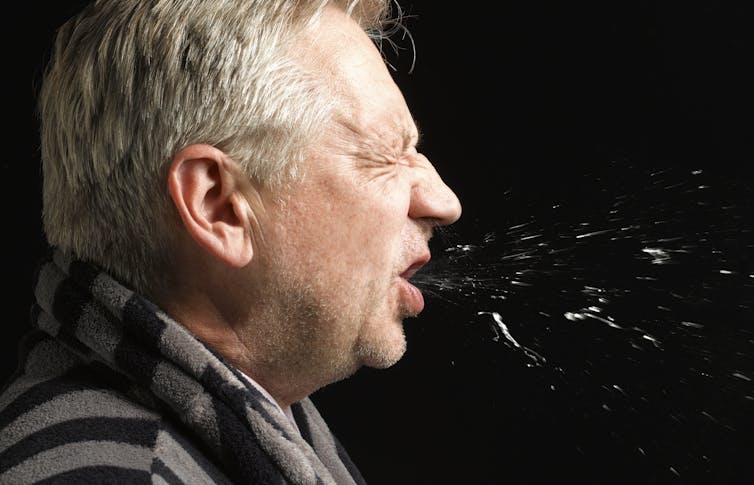
From your lungs into the air around you, aerosols carry coronavirus.
Peter Dazeley/The Image Bank via Getty Images
Shelly Miller, University of Colorado Boulder
During the 1970s when I was growing up in Southern California, the air was so polluted that I was regularly sent home from high school to “shelter in place.” There might not seem to be much in common between staying home due to air pollution and staying home to fight the coronavirus pandemic, but fundamentally, both have a lot to do with aerosols.
Aerosols are the tiny floating pieces of pollution that make up Los Angeles’ famous smog, the dust particles you see floating in a ray of sunshine and also the small droplets of liquid that escape your mouth when you talk, cough or breathe. These small pieces of floating liquids can contain pieces of the coronavirus and can be major contributor to its spread.
If you walk outside right now, chances are you will see people wearing masks and practicing social distancing. These actions are in large part meant to prevent people from spreading or inhaling aerosols.
I am a professor of mechanical engineering and study aerosols and air pollution. The more people understand how aerosols work, the better people can avoid getting or spreading the coronavirus.
Airborne and everywhere
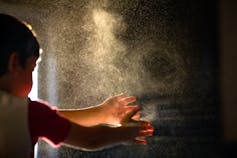
Aerosols are everywhere.
slobo/E+ via Getty Images
An aerosol is a clump of small liquid or solid particles floating in the air. They are everywhere in the environment and can be made of anything small enough to float, like smoke, water or coronavirus-carrying saliva.
When a person coughs, talks or breathes, they throw anywhere between 900 to 300,000 liquid particles from their mouth. These particles range in size from microscopic – a thousandth the width of a hair – up to the size of a grain of fine beach sand. A cough can send them traveling at speeds up to 60 mph.
Size of the particle and air currents affect how long they will stay in the air. In a still room, tiny particles like smoke can stay airborne for up to eight hours. Larger particles fall out of the air more quickly and land on surfaces after a few minutes.
By simply being near other people, you are coming into constant contact with aerosols from their mouth. During a pandemic this a little more concerning than normal. But the important question is not do exhaled aerosols exist, rather, how infectious are they?
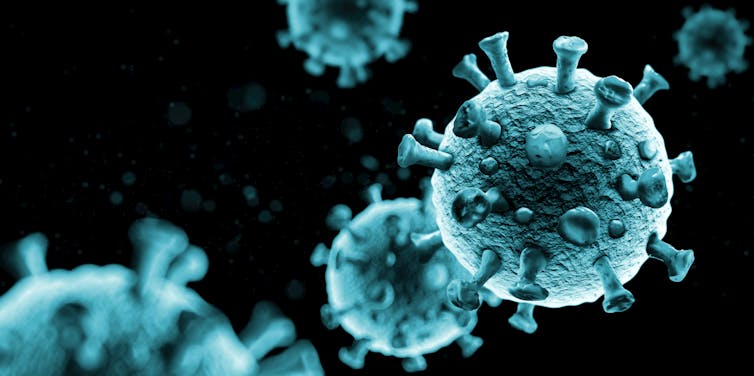
The coronavirus is small and easily transported by airborne particles of saliva.
fotograzia/Moment via Getty Images
Aerosols as virus delivery systems
The new coronavirus, SARS-CoV-2, is tiny, about 0.1 microns - roughly 4 millionths of an inch - in diameter. Aerosols produced by people when they breathe, talk and cough are generally between about 0.7 microns to around 10 microns – completely invisible to the naked eye and easily able to float in air. These particles are mostly biological fluids from people’s mouths and lungs and can contain bits of virus genetic material.
Researchers don’t yet know how many individual pieces of SARS-CoV-2 an aerosol produced by an infected person’s cough might hold. But in one preprint study, meaning it is currently under peer review, researchers used a model to estimate that a person standing and speaking in a room could release up to 114 infectious doses per hour. The researchers predict that these aerosolized bits of saliva would easily infect other people if this happened in public indoor spaces like a bank, restaurant or pharmacy.
Another thing to consider is how easy these particles are to inhale. In a recent computer model study, researchers found that people would most likely inhale aerosols from another person that is talking and coughing while sitting less than 6 feet away.
While this seems bad, the actual process from exposure to infection is a complicated numbers game. Often, viral particles found in aerosols are damaged. A study looking at the flu virus found that only 0.1% of viruses exhaled by a person are actually infectious. The coronavirus also starts to die off once it has left the body, remaining viable in the air for up to three hours. And of course, not every aerosol coming from an infected person will contain the coronavirus. There is a lot of chance involved.
Public health officials still don’t know whether direct contact, indirect contact through surfaces, or aerosols are the main pathway of transmission for the coronavirus. But everything experts like myself know about aerosols suggests that they could be a major pathway of transmission.
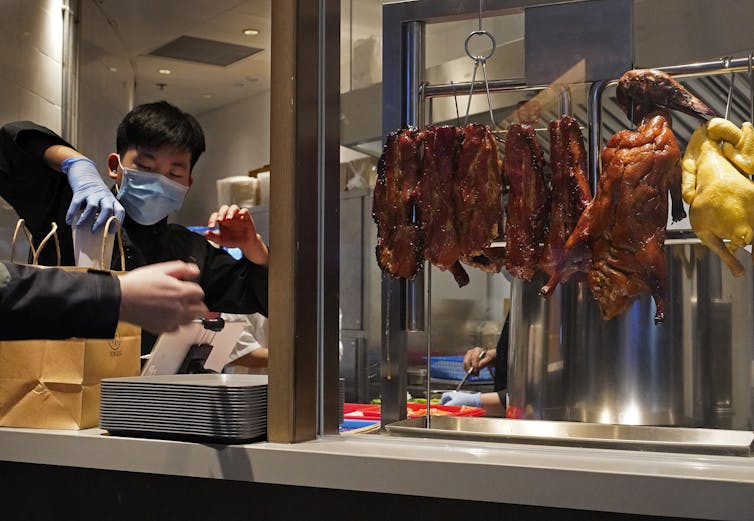
Aerosol driven outbreaks have been linked to restaurants, shops and many other public places.
AP Photo/Vincent Yu
Evidence of aerosol transmission
It is almost impossible to study viral transmission in real time, so researchers have turned to environmental sampling and contact tracing to try to study the spread of the coronavirus in aerosols. This research is happening extremely fast and most of it is still under peer review, but these studies offer extremely interesting, if preliminary, information.
To test the environment, researchers simply sample the air. In Nebraska, scientists found airborne SARS-CoV-2 in a hospital. In China, scientists also found the virus in the air of a number of hospitals as well as a department store.
But environmental sampling alone cannot prove aerosol transmission. That requires contact tracing.
One restaurant in Guangzhou, China, was the site of a small outbreak on Jan. 23 and offers direct evidence of aerosol transmission. Researchers believe that there was one infected but asymptomatic person sitting at a table in the restaurant. Because of the air currents circulating in the room due to air conditioning, people sitting at two other tables became infected, likely because of aerosols.
Overall, the evidence suggests that it is much more risky to be inside than outside. The reason is the lack of airflow. It takes between 15 minutes and three hours for an aerosol to be sucked outside by a ventilation system or float out an open window.
Another preprint study of outbreaks in Japan suggests that the chances of direct transmission are almost 20 times higher indoors compared to outdoors. In Singapore, researchers traced the first three outbreaks directly to a few shops, a banquet dinner and a church.
Once outside, these potentially infectious aerosols disappear in the expanse of the atmosphere and are much less of a worry. It is of course possible to catch the virus outside if you are in close contact with a sick person, but this seems very rare. Researchers in China found that only one of 314 outbreaks they examined could be traced back to outdoor contact.
There has been recent concern over aerosol transmission during running and biking. While the science is still developing on this, it is probably wise to give other bikers or runners a little more room than normal.
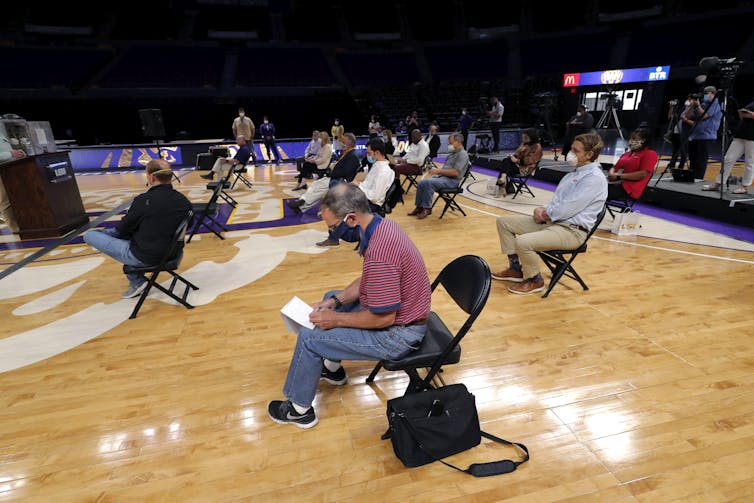
Wearing masks and social distancing reduce the risk of spreading or inhaling aerosols.
AP Photo/Gerald Herbert
How to reduce aerosol transmission
With all of this knowledge of how aerosols are produced, how they move and the role they play in this pandemic, an obvious question arises: what about masks?
The Centers for Disease Control and Prevention recommends wearing a face mask in any public setting where social distancing is hard to do. This is because homemade masks probably do a reasonable job of blocking aerosols from leaving your mouth. The evidence generally supports their use and more research is coming to show that masks can be very effective at reducing SARS-CoV-2 in air. Masks aren’t perfect and more studies are currently underway to learn how effective they really are, but taking this small precaution could help slow the pandemic.
Other than wearing a mask, follow common sense and the guidance of public health officials. Avoid crowded indoor spaces as much as possible. Practice social distancing both inside and outdoors. Wash your hands frequently. All of these things work to prevent the spread of the coronavirus and can help keep you from getting it. There is a significant amount of evidence that COVID-19 is transmitted by the inhalation of airborne particles, but by carefully following the advice of experts, individuals can minimize the risk they pose.
[Get facts about coronavirus and the latest research. Sign up for The Conversation’s newsletter.]

Shelly Miller, Professor of Mechanical and Environmental Engineering, University of Colorado Boulder
This article is republished from The Conversation under a Creative Commons license. Read the original article.

From your lungs into the air around you, aerosols carry coronavirus.
Peter Dazeley/The Image Bank via Getty Images
Shelly Miller, University of Colorado Boulder
During the 1970s when I was growing up in Southern California, the air was so polluted that I was regularly sent home from high school to “shelter in place.” There might not seem to be much in common between staying home due to air pollution and staying home to fight the coronavirus pandemic, but fundamentally, both have a lot to do with aerosols.
Aerosols are the tiny floating pieces of pollution that make up Los Angeles’ famous smog, the dust particles you see floating in a ray of sunshine and also the small droplets of liquid that escape your mouth when you talk, cough or breathe. These small pieces of floating liquids can contain pieces of the coronavirus and can be major contributor to its spread.
If you walk outside right now, chances are you will see people wearing masks and practicing social distancing. These actions are in large part meant to prevent people from spreading or inhaling aerosols.
I am a professor of mechanical engineering and study aerosols and air pollution. The more people understand how aerosols work, the better people can avoid getting or spreading the coronavirus.
Airborne and everywhere

Aerosols are everywhere.
slobo/E+ via Getty Images
An aerosol is a clump of small liquid or solid particles floating in the air. They are everywhere in the environment and can be made of anything small enough to float, like smoke, water or coronavirus-carrying saliva.
When a person coughs, talks or breathes, they throw anywhere between 900 to 300,000 liquid particles from their mouth. These particles range in size from microscopic – a thousandth the width of a hair – up to the size of a grain of fine beach sand. A cough can send them traveling at speeds up to 60 mph.
Size of the particle and air currents affect how long they will stay in the air. In a still room, tiny particles like smoke can stay airborne for up to eight hours. Larger particles fall out of the air more quickly and land on surfaces after a few minutes.
By simply being near other people, you are coming into constant contact with aerosols from their mouth. During a pandemic this a little more concerning than normal. But the important question is not do exhaled aerosols exist, rather, how infectious are they?

The coronavirus is small and easily transported by airborne particles of saliva.
fotograzia/Moment via Getty Images
Aerosols as virus delivery systems
The new coronavirus, SARS-CoV-2, is tiny, about 0.1 microns - roughly 4 millionths of an inch - in diameter. Aerosols produced by people when they breathe, talk and cough are generally between about 0.7 microns to around 10 microns – completely invisible to the naked eye and easily able to float in air. These particles are mostly biological fluids from people’s mouths and lungs and can contain bits of virus genetic material.
Researchers don’t yet know how many individual pieces of SARS-CoV-2 an aerosol produced by an infected person’s cough might hold. But in one preprint study, meaning it is currently under peer review, researchers used a model to estimate that a person standing and speaking in a room could release up to 114 infectious doses per hour. The researchers predict that these aerosolized bits of saliva would easily infect other people if this happened in public indoor spaces like a bank, restaurant or pharmacy.
Another thing to consider is how easy these particles are to inhale. In a recent computer model study, researchers found that people would most likely inhale aerosols from another person that is talking and coughing while sitting less than 6 feet away.
While this seems bad, the actual process from exposure to infection is a complicated numbers game. Often, viral particles found in aerosols are damaged. A study looking at the flu virus found that only 0.1% of viruses exhaled by a person are actually infectious. The coronavirus also starts to die off once it has left the body, remaining viable in the air for up to three hours. And of course, not every aerosol coming from an infected person will contain the coronavirus. There is a lot of chance involved.
Public health officials still don’t know whether direct contact, indirect contact through surfaces, or aerosols are the main pathway of transmission for the coronavirus. But everything experts like myself know about aerosols suggests that they could be a major pathway of transmission.

Aerosol driven outbreaks have been linked to restaurants, shops and many other public places.
AP Photo/Vincent Yu
Evidence of aerosol transmission
It is almost impossible to study viral transmission in real time, so researchers have turned to environmental sampling and contact tracing to try to study the spread of the coronavirus in aerosols. This research is happening extremely fast and most of it is still under peer review, but these studies offer extremely interesting, if preliminary, information.
To test the environment, researchers simply sample the air. In Nebraska, scientists found airborne SARS-CoV-2 in a hospital. In China, scientists also found the virus in the air of a number of hospitals as well as a department store.
But environmental sampling alone cannot prove aerosol transmission. That requires contact tracing.
One restaurant in Guangzhou, China, was the site of a small outbreak on Jan. 23 and offers direct evidence of aerosol transmission. Researchers believe that there was one infected but asymptomatic person sitting at a table in the restaurant. Because of the air currents circulating in the room due to air conditioning, people sitting at two other tables became infected, likely because of aerosols.
Overall, the evidence suggests that it is much more risky to be inside than outside. The reason is the lack of airflow. It takes between 15 minutes and three hours for an aerosol to be sucked outside by a ventilation system or float out an open window.
Another preprint study of outbreaks in Japan suggests that the chances of direct transmission are almost 20 times higher indoors compared to outdoors. In Singapore, researchers traced the first three outbreaks directly to a few shops, a banquet dinner and a church.
Once outside, these potentially infectious aerosols disappear in the expanse of the atmosphere and are much less of a worry. It is of course possible to catch the virus outside if you are in close contact with a sick person, but this seems very rare. Researchers in China found that only one of 314 outbreaks they examined could be traced back to outdoor contact.
There has been recent concern over aerosol transmission during running and biking. While the science is still developing on this, it is probably wise to give other bikers or runners a little more room than normal.

Wearing masks and social distancing reduce the risk of spreading or inhaling aerosols.
AP Photo/Gerald Herbert
How to reduce aerosol transmission
With all of this knowledge of how aerosols are produced, how they move and the role they play in this pandemic, an obvious question arises: what about masks?
The Centers for Disease Control and Prevention recommends wearing a face mask in any public setting where social distancing is hard to do. This is because homemade masks probably do a reasonable job of blocking aerosols from leaving your mouth. The evidence generally supports their use and more research is coming to show that masks can be very effective at reducing SARS-CoV-2 in air. Masks aren’t perfect and more studies are currently underway to learn how effective they really are, but taking this small precaution could help slow the pandemic.
Other than wearing a mask, follow common sense and the guidance of public health officials. Avoid crowded indoor spaces as much as possible. Practice social distancing both inside and outdoors. Wash your hands frequently. All of these things work to prevent the spread of the coronavirus and can help keep you from getting it. There is a significant amount of evidence that COVID-19 is transmitted by the inhalation of airborne particles, but by carefully following the advice of experts, individuals can minimize the risk they pose.
[Get facts about coronavirus and the latest research. Sign up for The Conversation’s newsletter.]

Shelly Miller, Professor of Mechanical and Environmental Engineering, University of Colorado Boulder
This article is republished from The Conversation under a Creative Commons license. Read the original article.

